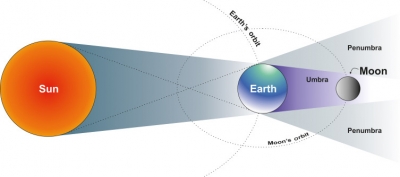
The temperature of the umbra is roughly 3,000–4,500 K (2,700–4,200 °C), in contrast to the penumbra at about 5,780 K (5,500 °C) leaving sunspots clearly visible as dark spots, occasionally visible even to the naked eye.
If you are within the Moon’s umbra and look into the direction of the Sun, you will see a total solar eclipse as the Moon blocks the all of the Sun. On its journey through space, the Moon always casts an umbra. This means that somewhere in space, on the dark side of the Moon, a total solar eclipse is happening right now.
The reason why solar eclipses are so rare is that the Moon’s umbra rarely hits the Earth’s surface. Even during a total solar eclipse, the umbra only covers a small area on Earth.
As both the Moon and the Earth are in constant motion, the umbra moves across the face of the Earth during the eclipse, so the total phase can usually only be seen along a slim eclipse path. For example, the total solar eclipse on April 8, 2024 will only be visible along a narrow belt stretching across the United States, Mexico, and Canada.
Like the Moon, Earth always casts an umbra. In fact, we travel through it quite regularly. It is called: night. Every time the Sun goes down, we delve into the darkness created by Earth’s umbra. However, as with total solar eclipses, lunar eclipses only occur every so often because they require the Moon to enter the Earth’s umbra.
The Earth’s umbra is involved in both total and partial lunar eclipses. During a total lunar eclipse, the entire Moon enters the umbra. A partial lunar eclipse occurs when the umbra covers only part of the Moon’s surface.
A penumbral lunar eclipse occurs when the Moon enters the Earth’s penumbra.
Credit : Time and Date
Picture Credit : Google




